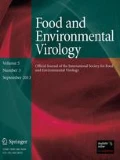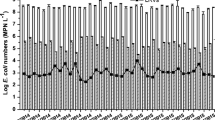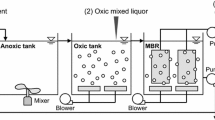Abstract
The capability of a cost-effective and a small size decentralized pilot wastewater treatment plant (WWTP) to remove enteric viruses such as rotavirus, norovirus genogroup I (GGI), norovirus genogroup II (GGII), Hepatitis E virus (HEV), and adenovirus was studied. This pilot plant is an integrated hybrid anaerobic/aerobic setup which consisted of anaerobic sludge blanket (UASB), biological aerated filter (BAF), and inclined plate settler (IPS). Both the UASB and BAF are packed with a non-woven polyester fabric (NWPF). Results indicated that the overall log10 reductions of enteric viruses’ genome copies through the whole system were 3.1 ± 1, 3.3 ± 0.5, and 2.6 ± 0.9 log10 for rotavirus, norovirus GGI, and adenovirus, respectively. Reduction efficiency for both norovirus GGII and HEV after the different treatment steps could not be calculated because there were no significant numbers of positive samples for both viruses. The overall reduction of rotavirus infectious units through the whole system was 2.2 ± 0.8 log10 reduction which is very close to the overall log10 reduction of adenovirus infectious units through the whole system which was 2.1 ± 0.8 log10 reduction. There was no considerable difference in the removal efficiency for different rotavirus G and P types. Adenovirus 41 was the only type detected in the all positive samples. Although the pilot WWTP investigated is cost effective, has a small footprint, does not need a long distance network pipes, and easy to operate, its efficiency to remove enteric viruses is comparable with the conventional centralized WWTPs.








Similar content being viewed by others
References
Abad, F. X., Pintó, R. M., Diez, J. M., & Bosch, A. (1994). Disinfection of human enteric viruses in water by copper and silver in combination with low levels of chlorine. Applied and Environment Microbiology, 60, 2377–2383.
Abad, F. X., Pintó, R. M., Villena, C., Gajardo, R., & Bosch, A. (1997). Astrovirus survival in drinking water. Applied and Environment Microbiology, 63, 3119–3122.
Abdo, S. M., Hetta, M. H., El-Senousy, W. M., Samhan, F. A., Salah El Din, R. A., & Ali, G. H. (2012). Antiviral activity of freshwater algae. Journal of Applied Pharmaceutical Science, 2, 21–25.
Abou-Elela, S. I., Fawzy, M. E., & El-Gendy, A. S. (2015). Potential of using biological aerated filter as a post treatment for municipal wastewater. Ecological Engineering Journal, 84, 53–57.
Abou-Elela, S. I., Fawzy, M. E., Emam, W. M., & Ghazy, M. M. (2013). Decentralized domestic wastewater treatment using a novel hybrid up-flow anaerobic sludge blanket followed by sand filtration. International Journal of Ecology and Environmental Sciences, 4(1), 91–96.
Abou-Elela, S. I., Hamdy, I. O., & El Monayeri, O. (2016a). Modeling and simulation of anaerobic/aerobic wastewater treatment system. International Journal of Environmental Science and Technology, 13(5), 1289–1298.
Abou-Elela, S. I., Harb, A. H., & Hellal, M. S. (2016b). Assessment of seasonal variations on the performance of P-UASB/BAF for municipal wastewater treatment. Desalination and Water Treatment Journal, 57, 17087–17094.
Atmar, R. L., Opekun, A. R., Gilger, M. A., Estes, M. K., Crawford, S. E., Neill, F. H., et al. (2008). Norwalk virus shedding after experimental human infection. Emerging Infectious Diseases, 14, 1553–1557.
Baggi, F., Demarta, A., & Peduzzi, R. (2001). Persistence of viral pathogens and bacteriophages during sewage treatment: Lack of correlation with indicator bacteria. Research in Microbiology, 152, 743–751.
Bosch, A. (2007). Human viruses in water (1st ed.). Amsterdam, Boston: Elsevier.
Bosch, A., Diez, J. M., & Abad, F. X. (1993). Disinfection of human enteric viruses in water by copper: Silver and reduced levels of chlorine. Water Science & Technology, 27, 351–356.
Breitbart, M., Hewson, I., Felts, B., Mahaffy, J. M., Nulton, J., Salamon, P., et al. (2003). Metagenomic analyses of an uncultured viral community from human feces. Journal of Bacteriology, 185, 6220–6223.
Cao, H., Tsai, F. T. C., & Rusch, K. A. (2010). Salinity and soluble organic matter on virus sorption in sand and soil columns. Ground Water, 48, 42–52.
Cho, H. B., Lee, S. H., Cho, J. C., & Kim, S. J. (2000). Detection of adenoviruses and enteroviruses in tap water and river water by reverse transcription multiplex PCR. Canadian Journal of Microbiology, 46, 417–424.
Costafreda, M. I., Bosch, A., & Pintó, R. M. (2006). Development, evaluation, and standardization of a real-time TaqMan reverse transcription-PCR assay for quantification of hepatitis a virus in clinical and shellfish samples. Applied and Environment Microbiology, 72(6), 3846–3855.
da Silva, A. K., Le Saux, J. C., Parnaudeau, S., Pommepuy, M., Elimelech, M., & Le Guyader, F. S. (2007). Evaluation of removal of noroviruses during wastewater treatment, using Real-Time Reverse Transcription-PCR: Different behaviors of genogroups I and II. Applied and Environment Microbiology, 73(24), 7891–7897.
de Roda Husman, A. M., & Bartram, J. (2008). Global supply of virus safe drinking water. In A. Bosch (Ed.), Human viruses in water (pp. 127–162). Amsterdam: Elsevier.
El-Senousy, W. M., Barakat, A. B., Ghanem, H. E., & Kamel, M. A. (2013a). Molecular epidemiology of human adenoviruses and rotaviruses as candidate viral indicators in the Egyptian sewage and water samples. World Applied Sciences Journal, 27, 1235–1247.
El-Senousy, W. M., Costafreda, M. I., Pintó, R. M., & Bosch, A. (2013b). Method validation for norovirus detection in naturally contaminated irrigation water and fresh produce. International Journal of Food Microbiology, 167, 74–79.
El-Senousy, W. M., El-Gamal, M. S., Mousa, A. A., El-Hawary, S. E., Kamel, M. M., Fathi, M. N., et al. (2014). Effect of chlorine on noroviruses, rotaviruses, and hepatitis E virus in drinking water. World Applied Sciences Journal, 32(11), 2206–2212.
El-Senousy, W. M., Guix, S., Abid, I., Pintó, R. M., & Bosch, A. (2007). Removal of astrovirus from water and sewage treatment plants, evaluated by a competitive reverse transcription-PCR. Applied and Environment Microbiology, 73, 164–167.
Esawy, M. A., Ahmed, E. F., Helmy, W. A., Mansour, N. M., El-Senousy, W. M., & El-Safty, M. M. (2011). Production of a halophilic levansucrase from novel honey Bacillus subtilis isolates capable of producing antiviral levans. Carbohydrate Polymers, 86, 823–830.
Espinosa, A. C., Arias, C. F., Sánchez-Colón, S., & Mazari-Hiriart, M. (2009). Comparative study of enteric viruses, coliphages and indicator bacteria for evaluating water quality in a tropical high-altitude system. Environment Health, 8, 49–58.
Espinosa, A. C., Mazari-Hiriart, M., Espinosa, R., Maruri Avidal, L., Méndez, E., & Arias, F. C. (2008). Infectivity and genome persistence of rotavirus and astrovirus in groundwater and surface water. Water Research, 42, 2618–2628.
Estrada, C. S. M. L., Velasquez, L. D. C., Genaro, S. D., & Guzman, A. M. S. D. (2007). Comparison of DNA extraction methods for pathogenic Yersinia enterocolitica detection from meat food by nested PCR. Food Research International, 40, 637–642.
Gallimore, C. I., Taylor, C., Genney, A. R., Cant, A. J., Galloway, A., Iturriza-Gomara, M., et al. (2006). Environmental monitoring for gastroenteric viruses in a pediatric primary immunodeficiency unit. Journal of Clinical Microbiology, 44, 395–399.
Gantzer, C., Maul, A., Audic, J. M., & Schwartzbrod, L. (1998). Detection of infectious enteroviruses, enterovirus genomes, somatic coliphages, and Bacteroides fragilis phages in treated wastewater. Applied and Environment Microbiology, 64, 4307–4312.
Gentsch, J. R., Glass, R. I., Woods, P. V., Gouvea, V., Gorziglia, M., Flores, J., et al. (1992). Identification of group A rotavirus gene 4 types by polymerase chain reaction. Journal of Clinical Microbiology, 30, 1365–1373.
Gerba, C. P., Gramos, D. M., & Nwachuku, N. (2002). Comparative inactivation of enteroviruses and adenovirus 2 by UV light. Applied and Environment Microbiology, 68, 5167–5169.
Gerba, C. P., & Rose, J. B. (1990). Viruses in source and drinking water. In G. A. McFeters (Ed.), Drinking water microbiology: Progress and recent developments (pp. 380–396). New York (NY): Springer-Verlag.
Ghazy, M. M. E., El-Senousy, W. M., Abdel- Aatty, A. M., Hegazy, B., & Kamel, M. (2008). Performance evaluation of a waste stabilization pond in a rural area in Egypt. American Journal of Environmental Sciences, 4, 316–326.
Gouvea, V., Glass, R. I., Woods, P., Taniguchi, K., Clark, H. F., Forrester, B., et al. (1990). Polymerase chain reaction amplification and typing of rotavirus nucleic acid from stool specimens. Journal of Clinical Microbiology, 28, 276–282.
Gouvea, V., Santos, N., & Carmo Timenetsky, M. (1994a). Identification of bovine and porcine rotavirus G types by PCR. Journal of Clinical Microbiology, 32, 1338–1340.
Gouvea, V., Santos, N., & Carmo Timenetsky, M. (1994b). VP4 typing of bovine and porcine group A rotavirus by PCR. Journal of Clinical Microbiology, 32, 1333–1337.
Greninger, A., Runckel, C., Chiu, C., Haggerty, T., Parsonnet, J., Ganem, D., et al. (2009). The complete genome of Klassevirus - a novel picornavirus in pediatric stool. Virology Journal, 6, 82–90.
Hao, X. D., Wang, Q. L., Zhu, J. Y., & Van Loosdrecht, M. C. M. (2010). Microbiological endogenous processes in biological wastewater treatment systems. Critical Reviews in Environment Science and Technology, 40, 239–265.
Hauri, A. M., Schimmelpfennig, M., Walter-Domes, M., Letz, A., Diedrich, S., Lopez-Pila, J., et al. (2005). An outbreak of viral meningitis associated with a public swimming pond. Epidemiology and Infection, 133, 291–298.
Havelaar, A. H., van Olphen, M., & Drost, Y. C. (1993). F-specific RNA bacteriophages are adequate model organisms for enteric viruses in fresh water. Applied and Environment Microbiology, 59, 2956–2962.
Iturriza Gomara, M., Wong, C., Blome, S., Desselberger, U., & Gray, J. (2002). Molecular characterization of VP6 genes of human rotavirus isolates: Correlation of genogroups with subgroups and evidence of independent segregation. Journal of Virology, 76, 6596–6601.
Jothikumar, N., Aparna, K., Kamatchiammal, S., Paulmurugan, R., Saravanadevi, S., & Khanna, P. (1993). Detection of hepatitis E virus in raw and treated wastewater. Environmental Microbiology, 59, 2558–2562.
Jurzik, L., Hamzaa, I. A., Puchert, W., Überla, K., & Wilhelm, M. (2010). Chemical and microbiological parameters as possible indicators for human enteric viruses in surface water. International Journal of Hygiene and Environmental Health, 213, 210–216.
Kageyama, T., Kojima, S., Shinohara, M., Uchida, K., Fukushi, S., Hoshino, F. B., et al. (2003). Broadly reactive and highly sensitive assay for Norwalk-like viruses based on real-time quantitative reverse transcription-PCR. Journal of Clinical Microbiology, 41, 1548–1557.
Kapperud, G., Vardnund, T., Skjerve, E., Hornes, E., & Michaelsen, T. E. (1993). Detection of pathogenic Yersinia enterocolitica in foods and water by immunomagnetic separation, nested polymerase chain reaction and colorimetric detection of amplified DNA. Applied and Environment Microbiology, 59, 2938–2944.
Kasorndorkbua, C., Opriessnig, T., Huang, F. F., Guenette, D. K., Thomas, P. J., Meng, X. J., et al. (2005). Infectious swine hepatitis E virus present in pig manure storage facilities on United States farms, but evidence of water contamination is lacking. Applied and Environment Microbiology, 71, 7831–7837.
Kitajima, M., Iker, B. C., Pepper, I. L., & Gerba, C. P. (2014). Relative abundance and treatment reduction of viruses during wastewater treatment processes—identification of potential viral indicators. Science of the Total Environment, 489, 290–296.
Kojima, S., Kageyama, T., Fukuda, S., Hoshino, F., Shinohara, M., Uchida, K., et al. (2002). Genogroup-specific PCR primer for detection of Norwalk-like viruses. Journal of Virological Methods, 100, 107–114.
Le Guyader, F. S., Parnaudeau, S., Schaeffer, J., Bosch, A., Loisy, F., Pommepuy, M., et al. (2009). Detection and quantification of noroviruses in shellfish. Applied and Environment Microbiology, 75, 618–624.
Lewis, G. D., & Metcalf, T. G. (1988). Polyethylene glycol precipitation for recovery of pathogenic viruses, including hepatitis A virus and human rotavirus, from oyster, water, and sediment samples. Applied and Environment Microbiology, 54, 1983–1988.
Loisy, F., Atmar, R. L., Guillon, P., Le Cann, P., Pommepuy, M., & Le Guyader, F. S. (2005). Real-time RT-PCR for norovirus screening in shellfish. Journal of Virological Methods, 123(1), 1–7.
Miagostovich, M. P., Ferreira, F. F., Guimaraes, F. R., Fumian, T. M., Diniz-Mendes, L., Luz, S. L., et al. (2004). The challenge of emerging and re-emerging infectious diseases. Nature, 430, 242–249.
Pintó, R. M., Costafreda, M. I., & Bosch, A. (2009). Risk assessment in shellfish-borne outbreaks of hepatitis A. Applied and Environment Microbiology, 75, 7350–7355.
Puig, M., Jofre, J., Lucena, F., Allard, A., Wadell, G., & Girones, R. (1994). Detection of adenoviruses and enteroviruses in polluted waters by nested PCR amplification. Applied and Environment Microbiology, 60, 2963–2970.
Pusch, D., Oh, D. Y., Wolf, S., Dumke, R., Schröter-Bobsin, U., Höhne, M., et al. (2005). Detection of enteric viruses and bacterial indicators in German environmental waters. Archives of Virology, 150, 929–947.
Ramani, S., & Kang, G. (2009). Viruses causing childhood diarrhea in the developing world. Current Opinion in Infectious Diseases, 22, 477–482.
Rose, J. B., Singh, S. N., Gerba, C. P., & Kelley, L. M. (1984). Comparison of microporous filters for concentration of viruses from wastewater. Applied and Environment Microbiology, 47, 989–992.
Rzeżutka, A., & Cook, N. (2004). Survival of human enteric viruses in the environment and food. FEMS Microbiology Reviews, 28, 441–453.
Skraber, S., Gassilloud, B., & Gantzer, C. (2004a). Comparison of coliforms and coliphages as tools for assessment of viral contamination in river water. Applied and Environment Microbiology, 70, 3644–3649.
Skraber, S., Gassilloud, B., Schwartzbrod, L., & Gantzer, C. (2004b). Survival of infectious Poliovirus-1 in river water compared to the persistence of somatic coliphages, thermotolerant coliforms and Poliovirus-1 genome. Water Research, 38, 2927–2933.
Smith, E. M., & Gerba, C. P. (1982). Development of a method for detection of human rotavirus in water and sewage. Applied and Environment Microbiology, 43, 1440–1450.
Svraka, S., Duizer, E., Vennema, H., de Bruin, E., van der Veer, B., Dorresteijn, B., et al. (2007). Etiological role of viruses in outbreaks of acute gastroenteritis in The Netherlands from 1994 through 2005. Journal of Clinical Microbiology, 45(5), 1389–1394.
Templeton, M. R., Andrews, R. C., & Hofmann, R. (2008). Particle-associated viruses in water: impacts on disinfection processes. Critical Reviews in Environment Science and Technology, 38, 137–164.
Thompson, S. S., Jackson, J. L., Suva-Castillo, M., Yanko, W. A., El Jack, Z., Kuo, J., et al. (2003). Detection of infectious human adenoviruses in tertiary-treated and ultraviolet-disinfected wastewater. Water Environment Research, 75, 163–170.
Van den Berg, H., Lodder, W., van der Poel, W. H. M., Vennema, H., & de Roda Husman, A. M. (2005). Genetic diversity of noroviruses in raw and treated sewage water. Research in Microbiology, 156, 532–540.
Van Heerden, J., Ehlers, M. M., Van Zyl, W. B., & Grabow, W. O. K. (2003). Incidence of adenoviruses in raw and treated water. Water Research, 37, 3704–3708.
Vantarakis, A., & Papapetropoulou, M. (1999). Detection of enteroviruses, adenoviruses and hepatitis A viruses in raw sewage and treated effluents by nested-PCR. Water, Air, and Soil pollution, 114, 85–93.
WHO. (1989). Health guidelines for the use of wastewater in agriculture and aquaculture (pp. 74). Report of a WHO Scientific Group. WHO Technical Report Series 778. World Health Organization, Geneva.
Wong, K., Mukherjee, B., Kahler, A. M., Zepp, R., & Molina, M. (2012). Influence of inorganic ions on aggregation and adsorption behaviors of human adenovirus. Environmental Science and Technology, 46, 11145–11153.
Xagoraraki, I., Yin, Z., & Svambayev, Z. (2014). Fate of viruses in water systems. Journal of Environmental Engineering, 140, 1–18.
Weiland, P. & Wulfert, K. (1988). Anaerobic treatment of stillage using different pilot scale fixed bed reactors in up and down mode of operation. In: Proceedings of the 5th International Symposium on Anaerobic Digestion, Bologna, Italy, 147–154.
Zhang, T., Breitbart, M., Lee, W. H., Run, J. Q., Wei, C. L., Soh, S. W. L., et al. (2006). RNA viral community in human feces: Prevalence of plant pathogenic viruses. PLoS Biology, 4, 108–118.
Zhang, C. M., Xu, L. M., Xu, P. C., & Wang, X. C. (2016). Elimination of viruses from domestic wastewater: Requirements and technologies. World Journal of Microbiology & Biotechnology, 32, 69–77.
Acknowledgement
The authors would like to thank the Egyptian Academy of Scientific Research and Technology (ASRT), the Science and Technology Development fund (STDF) for basic, and research Grant No. 1088.
Author information
Authors and Affiliations
Corresponding author
Electronic supplementary material
Below is the link to the electronic supplementary material.
Rights and permissions
About this article
Cite this article
El-Senousy, W.M., Abou-Elela, S.I. Assessment and Evaluation of an Integrated Hybrid Anaerobic–Aerobic Sewage Treatment System for the Removal of Enteric Viruses. Food Environ Virol 9, 287–303 (2017). https://doi.org/10.1007/s12560-017-9286-4
Received:
Accepted:
Published:
Issue Date:
DOI: https://doi.org/10.1007/s12560-017-9286-4




